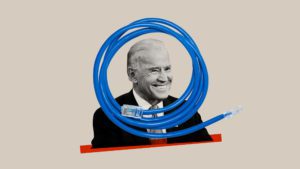The Biden Administration is currently waging a war on private broadband providers. How and why is this happening?
President Biden and his liberal friends in Congress continue to spread false information about what is happening in real time with high-speed broadband service, hoping that a majority in Congress will join them in supporting government-owned and operated broadband networks – the worst possible scenario for connecting every household that wants a high-speed Internet connection. Case in point: in President Biden’s July 9, 2021 Executive Order on Promoting Competition in the American Economy, he stated that “Americans…pay too much for broadband.” As history has taught us: repeat a lie often enough and people will believe it.
 On Aug. 10, the U.S. Senate passed a whopping $1.1 trillion “infrastructure” bill – the first part of their left-wing, special interest spend-a-thon. If successful in Congress, their final package of an additional $3.5 trillion in spending would be the largest tax-and-spend bill in the history of the world.
On Aug. 10, the U.S. Senate passed a whopping $1.1 trillion “infrastructure” bill – the first part of their left-wing, special interest spend-a-thon. If successful in Congress, their final package of an additional $3.5 trillion in spending would be the largest tax-and-spend bill in the history of the world.
The grotesque level of spending is bad enough but embedded in the $65 billion designated for broadband expansion includes a “social justice approach” to broadband connectivity.
- This legislation forces every private company or government provider to “offer a plan for low-income consumers at rates set by the state.” The bill “also includes the radical Digital Equity Act of 2021.”
- “It directs $2.75 billion toward the stated goal of “achieving digital equity is a matter of social and economic justice.” The Digital Equity Act spending doesn’t end with the 2021 infrastructure bill: it will become a permanent entitlement that will eventually cripple our economy and do little to connect those truly “unserved” by broadband providers today.
Private industry is connecting more and more households today – oftentimes with a local government matching grant to reach those without service. And, they are expanding lightning-fast broadband speeds at very affordable prices. But you would never know that if you listened to the debate in Washington. They would have you believe that “but for Congress” intervening, many Americans would never have the opportunity for high-speed Internet connections. Yet the facts tell a very different story.
- According to a recent study conducted by the Free State Foundation, “prices for entry level tiers [of broadband service] dropped by 9.1 percent (10.8 percent when adjusted for inflation), for the most popular tiers by 7.5 percent (9.3 when adjusted for inflation), and for the highest speed tiers by 2.3 percent (4.2 percent when adjusted for inflation).
- “By contrast, and according to the U.S. Bureau of Labor Statistics, the price of other high-demand consumer goods over the past year either rose or remained the same…Whereas broadband tier prices have fallen between 2 and 9 percent, prices for the vast majority of good traced by the Consumer Price Index (CPI) have risen – some by as much as 44 (fuel oil) and 52 percent (gasoline), and on average by over 7 percent.”
Indeed, during the COVID-19 pandemic, increased demand for super high-speed broadband has increased dramatically and private industry has responded accordingly. According to industry analysts, “internet service providers (ISP) consistently spend roughly $80 billion annually on broadband infrastructure, now totaling nearly $2 trillion overall.” This dynamic, private broadband expansion happened while on-line traffic exploded as more and more Americans worked from home: estimates are that on-line traffic grew between 40 and 60 percent during the past year as many of us worked and had children attending virtual school, all from home. All of this occurred while broadband prices – at every service level – decreased for almost every consumer. And yet the U.S. Senate decided to spend $65 billion to “fix” a problem that doesn’t really exist.
There isn’t much that most Americans agree upon these days but deployment of broadband to those who still need a connection is likely something we can all support. But we won’t achieve it by throwing gobs and gobs of taxpayer money in a Washington-designed, top-down, government-run and highly regulated program. Instead, Washington should get out of the way and allow the innovative and highly cost-effective solutions to expanding broadband happening every day all across the country to be enacted.




